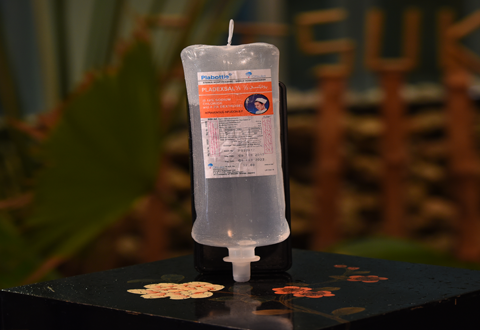
Electrolyte Solutions - PLADEXSAL 1/5
(4.3% Dextrose and 0.18% Sodium Chloride Intravenous Infusion B.P.)
Therapeutic Class
- Crystalloid solution with carbohydrate source.
Description and Composition
A clear, colorless solution, each 1000 ml. of which contains:
| Dextrose Monohydrate equivalent Or Anhydrous Dextrose B.P. | 43.0 grams |
| Sodium Chloride B.P. | 1.80 grams |
| Water for Injections | q.s. |
Pharmacological Effects
- Pladexsal 1/5 has an electrolyte composition of sodium and chloride approximately 1/5 and 1/3 of plasma respectively.
- Supplies body water for hydration.
- Provides 810 ml. of Free Water/Liter of solution.
| Sodium | 30 mEq |
| Chloride. | 30 mEq |
- Provides calories for some metabolic needs. Each 100mL provides 5 grams of Dextrose and each gram of Dextrose Monohydrate provides 3.4kCal. Depending on the presence of insulin, glucose enters cells and is broken down to pyruvate. With adequate oxygen, it enters the Kreb's cycle in the mitochondria and is converted into energy (A.T.P.), CO2 and H2O. The brain does not require insulin for glucose metabolism.
- The pH range is 3.5 - 6.5.
Indications
- Hypovolemic states including dehydration.
- Recommended as an initial solution for rehydration, for the supply of water and electrolytes in neonates and infants.
- Used to supply or replenish water and electrolytes before, during and after surgery particularly in neonates and infants.
- Indicated for the supply or replenishment of water and electrolytes in cases of possible potassium retention such as anuria, oliguria, hyperkalemia, and increased BUN, particularly in neonates and infants.
Dosage and Administration
The dose is dependent upon the age, weight and clinical condition of the patient. The infusion rate should be adjusted to provide 300-500 ml/hour (about 75-125 drops/minute) for adults and 50-100 ml/hour (about 12-25 drops/minute) for children.
In neonates and pre-term babies’ infusion of more than 100 ml/hour should be avoided.
Duration of Action and Excretion
Passes out of the blood stream quite rapidly, especially when normal renal function and renal blood flow are present.
Adverse Effects
- Fluid overload
- Congestive heart failure.
- Water intoxication may occur if infused rapidly or in large amounts.
- Hyperglycemia
Contraindications
- Congestive heart failure.
- Renal failure.
- Elevated blood glucose concentration.
Precautions
- Care is required in patients with cardiac failure and severe liver damage and in cases where salt intake is restricted as the solution contains sodium chloride 1.8 grams/Liter.
- Care is required in diabetics.
- Monitor E.C.G. continuously.
- Frequently monitor blood pressure, pulse rate and respiratory rate.
- Frequently auscultate breath sounds for rales.
Tonicity and Osmolarity
- Hypotonic solution having a tonicity of 30. Isosmotic solution (300 mOsm/L)
Caloric Value
160 kCal/Liter
Pharmaceutical Precautions
- Store at room temperature. Protect from sunlight.
- Do not use if bottle is leaking, solution is cloudy or contains foreign matter.
- Discard unused portion.
- Keep all medicines out of the reach of children.
Packaging
500ml in Plabottle.

